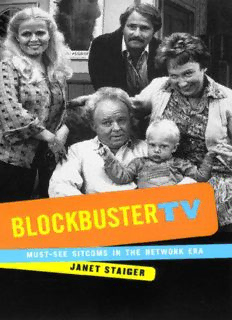
Blockbuster TV: Must-See Sitcoms in the Network Era PDF
Preview Blockbuster TV: Must-See Sitcoms in the Network Era
Blockbuster TV Blockbuster TV Must-See Sitcoms in the Network Era JANET STAIGER a NEW YORK UNIVERSITY PRESS New York and London NEW YORK UNIVERSITY PRESS New York and London Copyright © 2000 by New York University All rights reserved Library of Congress Cataloging-in-Publication Data Staiger, Janet. Blockbuster TV : must-see sitcoms in the network era / Janet Staiger. p. cm. Includes bibliographical references and index. ISBN 0-8147-9756-3 (cloth : acid-free paper) — ISBN 0-8147-9757-1 (paper : acid-free paper) 1. Television comedies—United States—History and criticism. I. Title. PN1992.8.C66 S718 2000 791.45'617—dc21 00-009853 New York University Press books are printed on acid-free paper, and their binding materials are chosen for strength and durability. Manufactured in the United States of America 10 9 8 7 6 5 4 3 2 1 To JoAnn, Don, and Diane, in delighted memory of our childhood Contents Preface / ix 1. Introduction / 1 2. The Beverly Hillbillies / 54 3. All in the Family / 81 4. Laverne & Shirley / 112 5. The Cosby Show / 141 Epilogue: Some Final Observations / 160 Notes / 177 Select Bibliography / 205 Index / 215 About the Author / 221 vii Preface This little book isn’t meant to be anything like a full picture of the television industry, American broadcasting audiences, or the events around the four situation comedies studied. Rather it is designed to be provocative—a gesture toward thinking about and researching the public reception of TV programs in relation to the institutional dynamics of network- era television. The process of writing this book has been somewhat eye- opening. As I shall discuss in chapter 1, I am considering four blockbuster sitcoms, defined as a series program that achieved audience ratings markedly higher than those of any of its con- tenders, week after week, after 1960 (usually the date selected as the time by which almost every U.S. household had a tele vision set and enough stations operated to provide adequate competition for audiences). The programs that meet these cri teria are The Beverly Hillbillies, All in the Family, Laverne & Shirley (with Happy Days), and The Cosby Show. While doing this research, I enjoyed presenting these cri teria to academic colleagues and asking them to guess which programs fit this definition. Invariably, their first an swers included The Mary Tyler Moore Show, M*A*S*H, Roseanne, and Seinfeld. Although very popular programs, none of these sitcoms fits this definition of a blockbuster. What these programs do coordinate with is, likely, acade mic taste preferences. I spend a great deal of effort (and some charts) in chapter 1 exploring what exactly were the ix
Description: